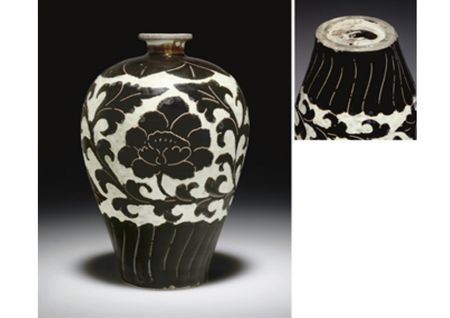A Very Rare Cizhou Carved Meiping, Northern Song Dynasty, Late 11th-12th Century
A Very Rare Cizhou Carved Meiping, Northern Song Dynasty, Late 11th-12th Century
Well carved with a broad band of peony scroll bearing three large blossoms framed by leafy, curving stems between a band of narrow overlapping petals below and overlapping leaf tips on the shoulder which issue from the base of the short neck surmounted by a dished, everted mouth, all in dark brown reserved on a white slip ground and covered with a clear glaze through which the details have been incised, the recessed base with a splash of brown glaze on a white slip ground. 11 in. (28 cm.) high, box. Estimate $80,000 - $100,000
北宋 磁州窯黑地剔花梅瓶
11世紀晚期至12世紀
Provenance: Warren E. Cox & Associates, New York, 1966.
Exhibited: Inaugural Exhibition, The Miriam and Ira D. Wallach Art Gallery, Columbia University, 4 April 1986.
3500 Years of Chinese Art: Ceramics from the Arthur M. Sackler Collections, Israel Museum, Jerusalem, 1987.
Notes: The very difficult technique used to produce the striking design on this vase was developed at the Cizhou kilns in the Northern Song dynasty. It involved the application of a pale slip to the unfired stoneware vessel, followed by a dark slip. The outline of the decoration was then incised through the dark top layer and the background area of the design was cut away to reveal the pale slip beneath. Details, such as stamens and leaf veins, were also incised through the dark upper layer either with a fine point or a comb-like instrument. The thin colorless glaze could then be applied and the vessel fired.
This technique required very skillful application, since the slip layers were both relatively soft and the decorator had to judge exactly how deep to cut in order to remove the dark slip layer without accidentally cutting away the lower pale layer. When successfully rendered, the technique was, however, ideal for the depiction of dramatic large-scale floral motifs like those seen on the current vase. Sherds found at the Guantai kiln in Cixian, Hebei province include examples very similar to the current vase. These sherds are illustrated in the comprehensive report of the excavation of the Guantai kiln site: Guantai Cizhou yaozhi, Beijing, 1997, pl. 25-4 and col. pl. 21-2. The latter plate includes sherds displaying a similar overlapping petal motif around the foot of a vessel as seen on the current meiping. Some of the sherds are also decorated with similar floral scrolls.
Examples of meiping with similar decoration, including the overlapping petal band around the foot, the overlapping leaf tips on the shoulder, as well as the bold peony scroll in the main decorative area, are in several important international museum collections.
One such vase in the Gyoto Art Museum, Tokyo, is illustrated by G. Hasebe in Sekai toji zenshu - 12 - Song, Tokyo, 1977, p. 125, no. 119. Another example in the Ataka Collection is illustrated in Zhongguo taoci minpin zhan (An Exhibition of Great Examples of Chinese Ceramics: Masterpieces of Old Chinese Ceramics from the Ataka Collection), Tokyo, 1975, pl. 39. A meiping with very similar overlapping leaf tips on the shoulder, but with bands of peony scroll arranged in two ranks and with large overlapping leaves around the base, is in the Meiyintang Collection. See R. Krahl, Chinese Ceramics from the Meiyintang Collection, vol. 3 (II), London, 2006, pp. 542-3, no. 1540.
For examples of the more common type, with bands of narrow petal lappets at the shoulder and foot, see the meiping in The Metropolitan Museum of Art, New York illustrated by S. G. Valenstein in A Handbook of Chinese Ceramics, New York, 1989 rev. ed., p. 93, pl. 88; the vase in the National Museum of Korea, Seoul, illustrated by G. Hasebe, Sekai toji zenshu, op. cit., p. 278, no. 288; and the example from the Worcester Art Museum, illustrated by Y. Mino in Freedom of Clay and Brush through Seven Centuries in Northern China: Tz'u-chou type Wares, 960-1600 A.D., Indianapolis Museum of Art, 1980, pp. 102-3, where further examples are illustrated from the Kyoto National Museum, the Yamato Bunkakan, the Korean royal house of Yi, and the British Museum, figs. 97-100 respectively. See, also, the two meiping included in the Oriental Ceramic Society exhibition, The Arts of the Sung Dynasty, TOCS, vol. 32, 1959-1960, pl. 39, no. 92, from the collection of Mrs. Walter Sedgwick, and no. 103, from the collection of Monsieur Michel Bréal.
The result of Oxford Authentication Ltd. thermoluminescence test no. P108y83 is consistent with the dating of this lot.
Christie's. Fine Chinese Art From The Arthur M. Sackler Collections. 18 March 2009 New York, Rockefeller Plaza www.christies.com Image Christie's Ltd 2009

/https%3A%2F%2Fprofilepics.canalblog.com%2Fprofilepics%2F1%2F0%2F100183.jpg)



/http%3A%2F%2Fstorage.canalblog.com%2F50%2F01%2F119589%2F63223849_p.jpg)
/http%3A%2F%2Fstorage.canalblog.com%2F10%2F83%2F119589%2F62023112_p.jpg)
/http%3A%2F%2Fstorage.canalblog.com%2F37%2F94%2F119589%2F60183048_p.jpg)
/http%3A%2F%2Fstorage.canalblog.com%2F78%2F34%2F119589%2F56397799_p.jpg)